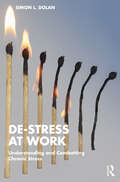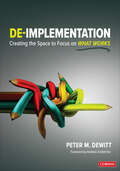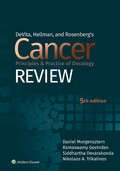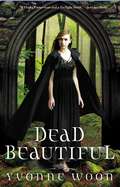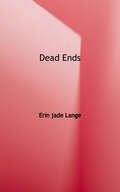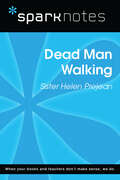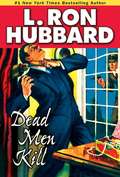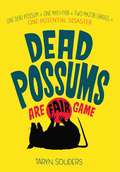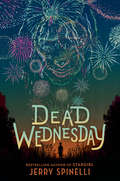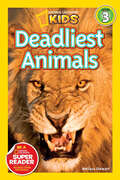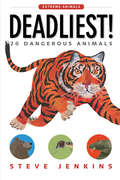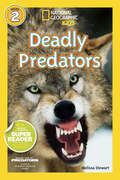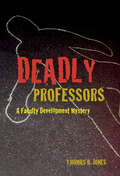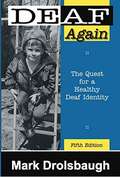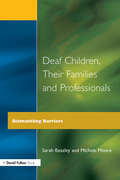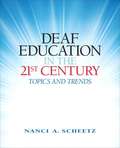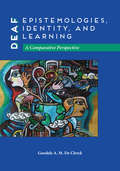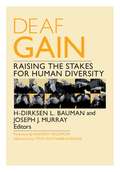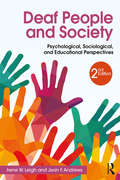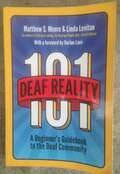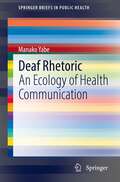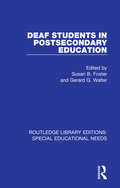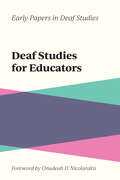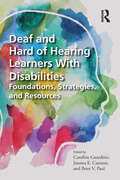- Table View
- List View
De-Stress at Work: Understanding and Combatting Chronic Stress
by Simon L. DolanBurn-out, excessive hours, office politics, handling complaints, isolated remote working, complex and inefficient processes – this book addresses the full complexities of chronic stress at work. It explains the potential for emotional and physical illness resulting from work, and importantly, presents ways in which occupational health and wellbeing can be enhanced through strengthening chronic stress diagnosis and promoting resilience. The latter is a win-win, for the worker, for the organization, and for society in general. Drawing on 40 years of research in collaboration with some of the best-known occupational stress gurus (including Cary Cooper, Susan Jackson, the late Ron Burke and Arie Shirom), Simon L. Dolan translates abstract concepts of chronic stress into practical guidance for enhancing resilience in a VUCA world. The ILO and many governments recognize stress as a principal cause of emerging physical and mental disease and one of the strongest determinants of high absenteeism, low morale and low productivity. While important advances have been made in the diagnosis of acute stress, the field of chronic stress in the workplace remains less clear. This book seeks to address this by presenting a wealth of diagnostic tools, including "The Stress Map". The text is brought to life for the reader by short vignettes in the form of anecdotes and stories. This book will be of particular interest to HR professionals, consultants, executive coaches, therapists and others who wish to help employees and clients better manage their own and others’ stress and to build resilience that leads to a more productive and healthier workforce.
De-implementation: Creating the Space to Focus on What Works
by Peter M. DeWittWhen it comes to school initiatives, more isn’t always better. Today’s educators are buried under old practices, new ideas, and recommended initiatives. The problem? With such an abundance of strategies, it’s hard to recognize what, if anything, is working. Before you’re tempted to add just one more idea to the pile, take a step back—and an objective look—so that you, central office leaders, building leaders, and teachers can decide which practices to keep, which to modify, and which to eliminate altogether. This guide provides A research- and evidence-based framework for determining efficacy Practical steps for removing, reducing, or replacing ineffective practices Action steps, examples, and tips for beginning the work—and getting teacher buy-in Templates for charting your school’s individual path to de-implementation Ineffective practices don’t just waste teacher time; they can have a catastrophic impact on student progress. Use de-implementation to shine a light on the path forward—one where teachers can focus on what works, and students can focus on learning.
De-implementation: Creating the Space to Focus on What Works
by Peter M. DeWittWhen it comes to school initiatives, more isn’t always better. Today’s educators are buried under old practices, new ideas, and recommended initiatives. The problem? With such an abundance of strategies, it’s hard to recognize what, if anything, is working. Before you’re tempted to add just one more idea to the pile, take a step back—and an objective look—so that you, central office leaders, building leaders, and teachers can decide which practices to keep, which to modify, and which to eliminate altogether. This guide provides A research- and evidence-based framework for determining efficacy Practical steps for removing, reducing, or replacing ineffective practices Action steps, examples, and tips for beginning the work—and getting teacher buy-in Templates for charting your school’s individual path to de-implementation Ineffective practices don’t just waste teacher time; they can have a catastrophic impact on student progress. Use de-implementation to shine a light on the path forward—one where teachers can focus on what works, and students can focus on learning.
DeVita, Hellman, and Rosenberg's Cancer Principles & Practice of Oncology Review
by Ramaswamy Govindan Daniel MorgenszternBased on DeVita, Hellman, and Rosenberg’s Cancer: Principles and Practice of Oncology, Eleventh Edition, this comprehensive review book covers the entire specialty of oncology, including new or expanded coverage of molecular biology; epidemiology and etiology; screen and prevention; genetics; clinical trials; and immunotherapy. Inside, readers will discover hundreds of multiple-choice and case-based questions, along with detailed answers and explanations to help explain the how and why behind each correct response. The ideal way to maximize exam scores for today’s student and residents! Learning and review features include: Hundreds of multiple-choice and case-based questions to build comprehension and improve retention. All topics cross-referenced to the latest edition of DeVita, Hellman, and Rosenberg’s Cancer: Principles & Practice of Oncology, Eleventh Edition. Material on all aspects of oncology, including medical, radiation and surgical oncology, as well as hematology/oncology issues.
Dead Beautiful
by Yvonne WoonA haunting love story about desire, danger, and destiny. Dead Beautiful is both a compelling romance and thought-provoking read, bringing shocking new meaning to life, death, love, and the nature of the soul.
Dead Ends
by Erin Jade LangeWhen Dane, a bully, refuses to hit Billy D. because he has Down syndrome, Billy takes that as a sign of friendship and enlists Dane's help in solving riddles left in an atlas by his missing father, sending the pair on a risky adventure
Dead Man Walking (SparkNotes Literature Guide Series)
by SparkNotesDead Man Walking (SparkNotes Literature Guide) by Helen Prejean Making the reading experience fun! Created by Harvard students for students everywhere, SparkNotes is a new breed of study guide: smarter, better, faster.Geared to what today's students need to know, SparkNotes provides:chapter-by-chapter analysis explanations of key themes, motifs, and symbols a review quiz and essay topics Lively and accessible, these guides are perfect for late-night studying and writing papers.
Dead Men Kill
by L. Ron HubbardBloodcurdling suspense... When several of the city's most respected citizens are inexplicably killed by what appear to be zombies, all Detective Terry Lane has to go on is a blue grey glove, a Haitian pharmacy bill for some very unusual drugs and a death threat from a mysterious stranger. Matters are soon complicated when a beautiful nightclub singer shows up who claims to have information that could solve the case, but whose motives are plainly suspect. Against his better judgment, Terry investigates her lead only to find himself sealed in a coffin en route to the next zombie murder--his own."DEAD MEN KILL is frightful fun from yesteryear."-- Fangoria* An International Book Awards Winner
Dead Possums Are Fair Game
by Taryn SoudersElla has two major phobias in life: spiders and mathematics. She firmly believes that anything with more than four legs should not exist. She also believes the world would be a better place without word problems or long division. That being said, she’s fascinated by science. So when her class finds a dead opossum in the playing field one morning, she’s intrigued by rigor mortis and how long it will take for the opossum to unstiffen. Science is so much more interesting than math. Later that day, Ella is certain she must have heard wrong when her teacher announces that there will be no more math tests for the rest of the year. And she isn’t wrong--it is too good to be true. Her teacher explains that instead, the class will be having its first ever math fair. Ella’s group is assigned the topic of time conversions, something Ella’s been struggling with for a while. This is hardly Ella’s idea of fun. But Ella’s mom is quick to point out that math and science aren’t so very different--she suggests that Ella imagine she’s doing a science experiment instead of a math project. With a little imagination and some inspiration from their friend the opossum (now named Morty, short for rigor mortis), Ella and her group come up with a project that gets them excited about math--and they might even have a chance to win at the fair!
Dead Wednesday
by Jerry SpinelliCan playing dead bring you back to life? Maybe only on Dead Wednesday… On this day the worlds of a shy boy and a gone girl collide, and the connection they make will change them both forever. A brilliant new novel from the Newbery Medal winner and author of the New York Times bestseller Stargirl. "Jerry Spinelli has created another middle grade masterpiece." —BookPage, starred review On Dead Wednesday, every eighth grader in Amber Springs is assigned the name and identity of a teenager who died a preventable death in the past year. The kids don black shirts and for the whole day everyone in town pretends they're invisible—as if they weren't even there. The adults think it will make them contemplate their mortality. The kids know it's a free pass to get away with anything. Worm Tarnauer feels invisible every day. He's perfectly happy being the unnoticed sidekick of his friend Eddie. So he's not expecting Dead Wednesday to feel that different. But he didn't count on being assigned Becca Finch (17, car crash). And he certainly didn't count on Becca showing up to boss him around! Letting this girl into his head is about to change everything. This is the story of the unexpected, heartbreaking, hilarious, truly epic day when Worm Tarnauer discovers his own life.
Deadliest Animals (Readers)
by Melissa StewartDid you know that a tiny golf ball-sized creature called the blue-ringed octopus contains enough venom to kill 26 adult humans? Or why the Sydney funnel web spider is one of the most dangerous creatures in the world? In this Level 3 book, kids will be fascinated by 12 species that you hope you'll never come across! Sharks, snakes, jellyfish and more—these creatures are among the most threatening—and interesting—in the world!National Geographic supports K-12 educators with ELA Common Core Resources.Visit www.natgeoed.org/commoncore for more information.
Deadliest!: 20 Dangerous Animals (Extreme Animals)
by Steve JenkinsWhat do a cape buffalo, a king cobra, and a puffer fish have in common? They're all deadly! Deadliest! showcases some of the planet’s most threatening creatures. Steve Jenkins's Extreme Animals reader series explores nature's truly superlative animals with the help of illustrations, infographics, facts, and figures while detailing the astounding abilities of critters as small as a frog or as big as a whale. Each installment focuses on truly amazing and unusual animals, making these nonfiction readers accessible, informative, and fascinating.
Deadly Predators (Readers)
by Melissa StewartCome face-to-face with sharks, wolves, tigers, and many more predators in this gripping new addition to the National Geographic Kids Reader series. Amazing animal photos will wow kids as they discover how predators hunt, raise their young, and contribute to the food chain. This Level 2 reader is written in easy-to-grasp text and will help kids understand who rules in the wild!
Deadly Professors: A Faculty Development Mystery
by Thomas B. JonesDespite flecks of the victim’s blood and what looked like part of an eyebrow, one could make out the letters etched in an artistic, painstaking script that formed the killer’s message:Hippocrite“Great. A perp who can’t spell,” said Jarvis.“So you think it’s a student?”Professor Roland Norris has been murdered in the early morning hours on the grounds of Välkommen University, and the discovery of the crime sets the scene for Thomas Jones’ new campus mystery. As two more murders rattle the university, St. Paul detectives LeRon Jarvis and Robert Phan increasingly focus on the victims’ connections to Jack Ramble, professor of literature and chair of the department.Are the crimes motivated by academic rivalries or the university’s finances? A frantic golf cart chase down the 10th fairway of the East Oaks Country Club finally reveals all…As with Thomas Jones’ previous academic mystery, The Missing Professor, this book is a parody of the mystery genre and campus life, but with a serious purpose. In 26 entertaining and succinct chapters, the story line raises such issues as the nature of today’s college students, faculty roles and responsibilities, mid-career concerns, the purpose of liberal education, racial diversity, micro-aggression, inclusive teaching, technology and learning, politics and the classroom, active learning, the role of sports in higher education, and academic freedom, to name but a few.This book will enliven, and ensure spirited discussion at any orientation, workshop, or faculty development activity.
Deaf Again: The Quest for a Healthy Deaf Identity
by Mark DrolsbaughJoin Mark Drolsbaugh in his fascinating journey from hearing toddler… to hard of hearing child… to deaf adolescent… and ultimately, to culturally Deaf adult. The struggle to find one’s place in the deaf community is challenging, as Drolsbaugh finds, yet there is one interesting twist: both his parents are also deaf. Even though the deaf community has always been there for him, right under his nose, Drolsbaugh takes the unbeaten path and goes on a zany, lifelong search… to become Deaf Again.
Deaf Children and Their Families
by Michele C. Moore Sarah BeazleyFirst Published in 1996. Routledge is an imprint of Taylor & Francis, an informa company.
Deaf Education in the 21st Century: Topics and Trends
by Nanci A. ScheetzAs the author writes in his preface to the edition, Deaf education in the 21st century has and will continue to undergo a rapid transformation primarily due to the advent of technological advances, innovative educational opportunities, and shrinking cultural boundaries. This text provides professionals, preservice teachers, interpreters, counselors, and other related personnel with a broad and balanced perspective on current topics and trends germane to the field today. In the coverage of a wide array of topics that include educational perspectives, psychosocial precepts, communication modes, cochlear implants, advances in hearing-aid technology, and other timely and relevant topics, the reader is exposed to a panoramic view of a complex field rather than an in-depth analysis of each of the major dimensions. This text is a sourcebook on the many dimensions found within the field of deaf education. Designed as a teaching-learning vehicle, basic concepts recur in varying situations, and illustrations and some concepts are repeated in diverging contexts to promote comprehension and enhance retention.
Deaf Epistemologies, Identity, and Learning: A Comparative Perspective
by Goedele A. De ClerckGoedele A. M. De Clerck presents cross-cultural comparative research that examines and documents where deaf flourishing occurs and how it can be advanced. She spotlights collective and dynamic resources of knowledge and learning; the coexistence of lived differences; social, linguistic, cultural, and psychological capital; and human potential and creativity. Deaf Epistemologies, Identity, and Learning argues for an inclusive approach to the intrinsic human diversity in society, education, and scholarship, and shows how emotions of hope, frustration, and humiliation contribute to the construction of identity and community. De Clerck also considers global to local dynamics in deaf identity, deaf culture, deaf education, and deaf empowerment. She presents empirical research through case studies of the emancipation processes for deaf people in Flanders (a region of Belgium), the United States (specifically, at Gallaudet University in Washington, DC), and the West African nation of Cameroon. These three settings illuminate different phases of emancipation in different contexts, and the research findings are integrated into a broader literature review and subjected to theoretical reflection. De Clerck’s anthropology of deaf flourishing draws from her critical application of the empowerment paradigm in settings of daily life, research, leadership, and community work, as she explores identity and well-being through an interdisciplinary lens. This work is centered around practices of signed storytelling and posits learning as the primary access and pathway to culture, identity, values, and change. Change driven by the learning process is considered an awakening—and through this awakening, the deaf community can gain hope, empowerment, and full citizenship. In this way, deaf people are allowed to shape their histories, and the result is the elevation of all aspects of deaf lives around the world.
Deaf Gain: Raising the Stakes for Human Diversity
by H-Dirksen L. Bauman Joseph J. MurrayDeaf people are usually regarded by the hearing world as having a lack, as missing a sense. Yet a definition of deaf people based on hearing loss obscures a wealth of ways in which societies have benefited from the significant contributions of deaf people. In this bold intervention into ongoing debates about disability and what it means to be human, experts from a variety of disciplines—neuroscience, linguistics, bioethics, history, cultural studies, education, public policy, art, and architecture—advance the concept of Deaf Gain and challenge assumptions about what is normal.Through their in-depth articulation of Deaf Gain, the editors and authors of this pathbreaking volume approach deafness as a distinct way of being in the world, one which opens up perceptions, perspectives, and insights that are less common to the majority of hearing persons. For example, deaf individuals tend to have unique capabilities in spatial and facial recognition, peripheral processing, and the detection of images. And users of sign language, which neuroscientists have shown to be biologically equivalent to speech, contribute toward a robust range of creative expression and understanding. By framing deafness in terms of its intellectual, creative, and cultural benefits, Deaf Gain recognizes physical and cognitive difference as a vital aspect of human diversity.Contributors: David Armstrong; Benjamin Bahan, Gallaudet U; Hansel Bauman, Gallaudet U; John D. Bonvillian, U of Virginia; Alison Bryan; Teresa Blankmeyer Burke, Gallaudet U; Cindee Calton; Debra Cole; Matthew Dye, U of Illinois at Urbana–Champaign; Steve Emery; Ofelia García, CUNY; Peter C. Hauser, Rochester Institute of Technology; Geo Kartheiser; Caroline Kobek Pezzarossi; Christopher Krentz, U of Virginia; Annelies Kusters; Irene W. Leigh, Gallaudet U; Elizabeth M. Lockwood, U of Arizona; Summer Loeffler; Mara Lúcia Massuti, Instituto Federal de Santa Catarina, Brazil; Donna A. Morere, Gallaudet U; Kati Morton; Ronice Müller de Quadros, U Federal de Santa Catarina, Brazil; Donna Jo Napoli, Swarthmore College; Jennifer Nelson, Gallaudet U; Laura-Ann Petitto, Gallaudet U; Suvi Pylvänen, Kymenlaakso U of Applied Sciences; Antti Raike, Aalto U; Päivi Rainò, U of Applied Sciences Humak; Katherine D. Rogers; Clara Sherley-Appel; Kristin Snoddon, U of Alberta; Karin Strobel, U Federal de Santa Catarina, Brazil; Hilary Sutherland; Rachel Sutton-Spence, U of Bristol, England; James Tabery, U of Utah; Jennifer Grinder Witteborg; Mark Zaurov.
Deaf People and Society: Psychological, Sociological and Educational Perspectives
by Irene W. Leigh Jean F. AndrewsDeaf People and Society incorporates multiple perspectives related to the topics of psychology, education, and sociology, including the viewpoints of deaf adults themselves. In doing so, it considers the implications of what it means to be deaf or hard of hearing and how deaf adults’ lives are impacted by decisions that professionals make, whether in the clinic, the school, or when working with family. This second edition has been thoroughly revised and offers current perspectives on the following topics:<P><P> * Etiologies of deafness and the identification process<P> * The role of auditory access<P> * Cognition, language, communication, and literacy<P> * Bilingual, bilingual/bimodal, and monolingual approaches to language learning<P> * Educational, legal, and placement aspects<P> * Childhood psychological issues<P> * Psychological and sociological viewpoints of deaf adults<P> * The criminal justice system and deaf people<P> * Psychodynamics of interaction between deaf and hearing people<P> Each chapter begins with a set of objectives and concludes with suggested readings for further research. This edition contains 10 new and original case studies, including ones on hearing children of deaf adults, sudden hearing loss, a young deaf adult with mental illness, and more. Written by a seasoned deaf/hearing bilingual team, this unique text continues to be the go-to resource for students and future professionals interested in working with deaf and hard-of-hearing persons.
Deaf Reality 101: Answers to Some Common Questions About the Deaf Community, Language, and Culture
by Matthew S. Moore Linda LevitanQuestions and answers on Deaf-related topics specifically for parents and students in noncredit classes
Deaf Rhetoric: An Ecology of Health Communication (SpringerBriefs in Public Health)
by Manako YabeThis book guides healthcare professionals, hospital administrators, and medical interpreters in the United States (and internationally) in ways to better communicate with Deaf and Hard of Hearing (D/HH) patients and sign language interpreters in healthcare settings. It also provides an overview of the healthcare communication issues with healthcare professionals and D/HH patients, and the advantages and disadvantages of using in-person interpreters vs. video remote interpreting (VRI). Due to technology development, hospital administrators have popularized the use of VRI and reduced the number of in-person interpreting services, which have negatively affected the quality of medical interpreting services and patient-provider communication. The COVID-19 pandemic also has accelerated the move toward more VRI, particularly in the US.The book addresses an understudied aspect of access and is written by an international deaf researcher from Japan who uses American Sign Language (ASL) and English as non-native languages. In order to identify appropriate interpreting services for specific treatments, the author focuses on healthcare professionals' and D/HH patients' interpreting preferences for critical and non-critical care in the US, and offers a new theoretical framework, an Ecology of Health Communication, to contextualize and analyze these preferences. The ecological matrix and its five analytical dimensions (i.e., physical-material, psychological, social, spatial, and temporal) allow readers to understand how these dimensions influence healthcare professionals' and D/HH patients' interpreting preferences as well as the treatment outcomes. This book concludes by prioritizing the use of an appropriate interpreter for specific treatments and allocating funds for in-person interpreters for critical care treatments.Deaf Rhetoric: An Ecology of Health Communication is primarily designed for healthcare professional students and professionals, hospital administrators, medical interpreters, VRI companies, and healthcare researchers. Scholars interested in the communication preferences of healthcare professionals and deaf people also will find this text useful. The book counters some of the power differences between healthcare providers and those who use medical services, and subtly reminds others that deaf people are not solely the receivers of medical care but actually are full people. The field of health care is growing and medical schools are increasingly called on to address cultural competencies; this resource provides a needed intervention.
Deaf Students in Postsecondary Education (Routledge Library Editions: Special Educational Needs #20)
by Susan B. Foster Gerard G. WalterFirst published in 1992. With an ever-increasing number of deaf students entering higher education throughout the world, major strides need to be made in provision and support for them. This book recognises that the integration of deaf students into mainstream higher education raises complex and challenging problems. It has proved extremely difficult for deaf students to enter fully into the social and extra-curricular fabric of campus life – an essential factor in ensuring student success. The authors provide an assessment of state-of-the-art practice in postsecondary settings and suggest theoretical and practical approaches to providing support. There is discussion of the attainments of deaf graduates with commentaries by deaf persons about their experiences in college. In addition, statistics support the theoretical contentions and clearly demonstrate the benefits of postsecondary education to deaf people.
Deaf Studies for Educators (Early Papers in Deaf Studies #2)
by Onudeah D. NicolarakisAs Deaf Studies emerged in the 1970s and 1980s as a field of academic study and inquiry, the importance of Deaf Studies in education became an area of interest among thought leaders of the time. Deaf Studies for Educators is a collection of papers from a 1991 conference convened to explore Deaf Studies as a framework for teaching and learning. American Sign Language literature and poetry, bilingual and bicultural programs, arts and history, and deaf identity are several of the topics covered. This collection captures how educators understood early on the benefits of a curriculum that was more fully inclusive and reflective of deaf culture and deaf experiences. A foreword by Onudeah D. Nicolarakis contextualizes the work for modern audiences. This is the second volume in the Early Papers in Deaf Studies series, which consists of reissued works originally published by the Gallaudet University College for Continuing Education but long out of print. The aim of this series is to restore these foundational papers to the scholarly community. Deaf Studies for Educators is available in both print and open digital formats, ensuring broad access to this important contribution to the literature.
Deaf and Hard of Hearing Learners With Disabilities: Foundations, Strategies, and Resources
by Peter V. Paul Caroline Guardino Joanna E. CannonThis volume offers foundational information and research-based strategies for meeting the needs of deaf and hard of hearing learners with disabilities. The disabilities covered in this volume include developmental delays, autism spectrum disorder, intellectual and learning disabilities, deafblindness, emotional and behavioral disorders, attention deficit hyperactivity disorder, and a variety of high incidence syndromes. Contributors examine the literature within each disability category, share best practices, and consider demographics/characteristics, intervention/identification, placement, communication/language, psychosocial issues, assistive technologies/accommodations, assessments, and transition/post-secondary outcomes. Each chapter begins with learning objectives and concludes with discussion questions and a resource list. Deaf and Hard of Hearing Learners with Disabilities is an essential book for courses at the undergraduate and graduate level, and in workshops and webinars for in-service teachers, professionals, and families.
